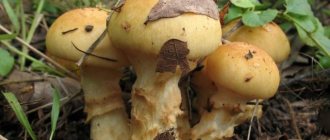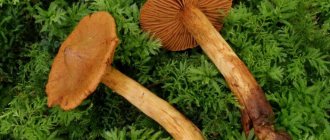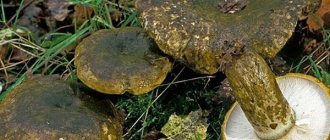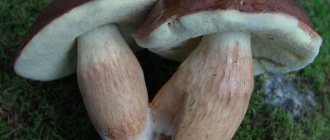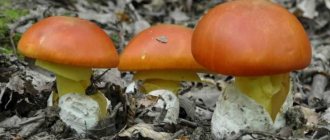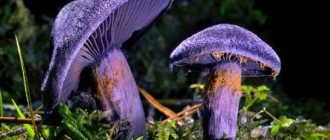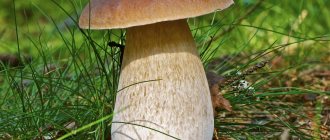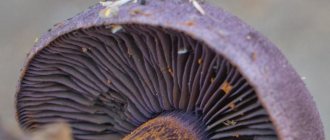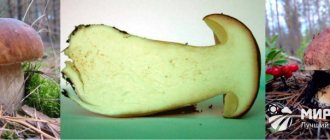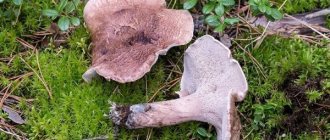Spider webs (Cortinarius) are a fairly extensive genus of fungi, numbering more than 40 species in our country, and throughout the world this figure exceeds the two thousandth threshold [1]. Most of their representatives are inedible, and some are even deadly poisonous. The name of some types of these mushrooms speaks for itself: just look at the superb cobweb or the elegant cobweb. Another name for them is swamp marshes or ringed caps.
Description and photo
Cobweb (lat. Cortinarius) is a genus of mushrooms of the family Cortinariaceae of the order Agaricales. In common parlance, this mushroom is better known as marsh grass.
A widespread but little-known mushroom, which is not surprising. Unusual colors and appearance often frighten and repel mushroom pickers. Its love for marshy soils does not add to its popularity. People traditionally treat mushrooms growing near swamps with distrust. And they do it right.
First aid for poisoning
Typical symptoms of spider web poisoning are: vomiting, a feeling of dry mouth, constant thirst, cramping abdominal pain. If these symptoms occur after eating a mushroom, you should immediately call a doctor. Transporting a patient with suspected mushroom poisoning on your own is dangerous, because some toxins affect the functioning of the heart. While waiting for the ambulance to arrive, you must:
- Perform gastric lavage.
- Give a laxative.
- Give a cleansing enema.
Poisonous mushrooms: description of toadstool
Then you should put the patient to bed and constantly water him with saline solutions and strong, chilled tea. You should not refuse recommended hospitalization, even if the patient feels better.
To summarize, we can say that collecting cobwebs is not a good idea for inexperienced mushroom pickers . Of course, their edible varieties have a very piquant taste, but a violation of the technology for preparing this product can result in a hospital bed for a person.
What does the spider mushroom look like?
The main distinguishing feature of this family is the presence of cortina - a cobweb-like thread-like blanket that falls from under the cap onto the stem.
These mushrooms come in a wide variety of sizes and colors. There are ocher, brown, yellow, white, bluish, red, olive green and even purple species. When cut, the color of the mushroom may differ from the main one.
Some varieties of cobwebs are even used to make natural, environmentally friendly paints.
The shape of the mushroom cap may vary depending on the species and age of the specimen. Most often they are hemispherical or conical, but sometimes there are cobwebs with a flat cap or even a concave one. The cap itself is characterized by a smooth or fibrous, dry surface, but there are species that are characterized by the formation of mucus or a scaly coating. The flesh in the cap is fleshy or relatively thin. Characterized by the presence of clearly defined thin and dense plates, which can be colored as varied as the main body of the fungus.
They have a clearly defined cylindrical leg, often with thickenings towards the base. As a rule, its appearance copies the color and structure of the cap.
The cobwebby cover of mature mushrooms appears in the form of a ring in the upper part of the stem immediately below the plates and a thin layer of threads along the edge of the cap. Young mushrooms, in addition to the above, are also covered with a cobwebby coating on top of the cap.
Cobwebs are a fairly common species, found both in Europe and the USA. In our country, these mushrooms live mainly in the European part.
Application
Cooking
Edible spider web mushrooms are considered a delicacy; they have a wonderful nutty taste. Tolstushka is delicious fried or stewed with sour cream or cream. Decoctions from the plum are used to make broth. The edible fruiting bodies are also pickled and dried, but this can result in the loss of much of the flavor.
The excellent cobweb is dried or pickled only after long soaking and boiling. Young specimens are suitable for pickling and salting. For your information. The shiny coating on the cap of the purple cobweb species disappears when dried.
Medicine
Used to obtain probiotics and extract valuable microelements. In industry, dyes are extracted from colored fruiting bodies. The species cannot be used in home medicine.
Is the spider web mushroom edible?
Most spider webs are considered inedible or poisonous mushrooms. And if everything is more or less clear about the toxicity of certain species, then opinions about edibility in various sources differ. In many cases, the consumption of these mushrooms for food also depends on heat treatment, which is not due to their toxicity, but rather to the low taste and peculiar texture of some species.
Some types of cobwebs, for example the purple cobweb, are quite rare mushrooms and are listed in the Red Books of many European countries.
Beneficial features
The web spider cannot be called harmless. Many members of this family are toxic, and some are even life-threatening. However, the beneficial substances that make up these mushrooms are widely used in medicine and the chemical industry . The following types are used for medicinal purposes:
Red (poisonous). The substances included in its biochemical composition prevent the development of tuberculosis.- Bracelet (conditionally edible). Has an antiseptic effect.
- Broken (poisonous). It contains alkaloids that are used in the treatment of diseases associated with memory impairment.
- Goat (inedible). It contains inolomine, which is a strong antibiotic.
There are quite a few edible species. They do not have the same aroma as porcini mushrooms or champignons, but they have an original taste and are large in size (up to 10 cm in stem height and up to 17 cm in cap diameter). Professional mushroom pickers enjoy collecting them for preparing fresh dishes and preserving them.
In culinary masterpieces, yellow webwort (also called triumphal), watery blue (sometimes called dove-blue), as well as superb and purple webwort are often used. All types of edible mushrooms can be boiled, fried, pickled, salted and canned.
Description of species
There are many varieties of this mushroom's edible diaspora to varying degrees. However, the likelihood of confusing its representative with its poisonous brother is extremely high. Therefore, let's look at some of the most common types in more detail.
| Name | category |
| bracelet | inedible non-toxic mushroom |
| lazy | toxic mushroom |
| excellent | excellent edible mushroom |
| white-violet | inedible non-toxic mushroom |
| purplish, or reddish | inedible non-toxic mushroom |
| red-olive | inedible non-toxic mushroom |
| brilliant | toxic mushroom |
| watery blue | good edible mushroom |
| triumphal | good edible mushroom |
| beautiful | toxic mushroom |
| violet | conditionally edible mushroom |
| terpsichores | inedible non-toxic mushroom |
| blood red | toxic mushroom |
| mountain or plush | deadly poisonous mushroom |
| purple | deadly poisonous mushroom |
Yellow
It is distinguished, according to its name, by a yellow, yellowish-brown or ocher cap. Rounded in a young mushroom, it tends to bend over time to become flat-convex.
Lilac or white-blue plates can also change their color to brown shades (in old specimens).
A tall stem, thickened at the base (more than 10 cm), slightly lighter in color than the cap. In adult fruiting bodies, reddish scales remain on the stem - remnants of the spathe.
The species has light-colored flesh, classic for edible mushrooms, pleasant in smell and taste.
The second name of the mushroom is triumphal.
Bracelet
The cap is 4-12 cm in diameter and ranges in color from orange to red-brown. A distinctive feature is the development of the fungal body in three stages:
- A neat hemispherical shape, completely hidden by cobwebs.
- Cushion stage: The rusty brown cap opens slightly and takes the shape of a lampshade.
- The hat opens completely, leaving a soft fibrous edge of the cover.
The mushroom has a musty smell characteristic of cobwebs - inedible.
Beginning mushroom pickers can easily confuse the bracelet webwort with the boletus, as it is often found under birch trees in deciduous forests and among mosses in mixed forests.
Excellent
The safest and most commonly eaten variety of spider webs.
Just like the bracelet mushroom, the mushroom develops in stages: a spherical cap covered with cobwebs; hemisphere; full disclosure. Dry and smooth caps of a pleasant soft brown color are covered with abundant sticky mucus in wet weather. This species has dense, white flesh and has a rather pleasant smell. As a rule, it chooses deciduous plantings as its habitat, but it can also be found in coniferous forests. The main condition is soil rich in lime.
In European countries, the superb cobweb is no less popular than the porcini mushroom. They even try to grow it at home.
White-violet
Another name for this species is bloated - this species is inedible.
The mushroom cap is whitish and has a distinct purple or lilac tint. Convex, has the shape of an open bell, often with a “crumpled” edge. Covered with mucus in the presence of abundant moisture. The pulp is thick, bluish, and smells musty.
Medium frequency, narrow plates tend to change color over time: from gray-blue to ocher or brown-brown.
The club-shaped leg reaches a length of 6 - 8 cm, below the girdle remaining from the web, it is usually covered with a thin layer of mucus. The color is white with a lilac tint. Silky and pleasant to the touch.
Scarlet
The cap of young mushrooms (up to 15 cm in diameter) has a characteristic convex shape, but during ripening it becomes flatter and stickier. The leg does not grow higher than 6 - 8 cm.
The species got its name from its noticeable reddish-brown color. You can recognize the mushroom by its characteristic darker spot in the central part of the cap.
The flesh of the mushroom changes color from light blue-white to purple if its integrity is somehow disturbed.
Despite the presence of a pleasant aroma, this mushroom has practically no taste at all. Category: inedible, non-toxic mushroom.
Red-olive
The age of these mushrooms, like many other varieties of spider webs, can be determined by the shape of their cap: convex and spherical in young bodies, flat and, as a rule, slimy in old ones. Color varies from purple to red-brown. The flesh is also purple, yellow in the middle.
The smell is completely inexpressive.
This species can be found in autumn in deciduous and mixed forests. Prefers to grow in groups. It is a fairly rare species of mushroom.
Brilliant
They have a mucus-covered cap not exceeding 12 cm in diameter. The shape transforms over time from hemispherical to convex. The color is characterized by shades of yellow and the presence of spots. The mushroom stem, like the flesh, is lemon-yellow, thickening at the bottom. Its length is 4-8 centimeters, and its girth ranges from 1 to 2 centimeters.
As the mushroom ages, the plates under the cap change color from yellow to green.
Despite the fact that the mushroom has a relatively pleasant smell of bread, this species is deadly poisonous! And although the necessary thermal treatment destroys the fungal toxin, it is not worth experimenting with this type.
The most special
The cap is up to 12 cm in diameter, spread out, with a tubercle in the center. Characterized by the presence of small scales. The color scheme varies from orange-brown to copper-red with an orange tint.
And although the light flesh of the mushroom has a pleasant taste and neutral radish smell, it is dangerous for humans. So dangerous that this mushroom is often compared to toadstool.
Found in swampy forests, along the edges of swamps from August to October.
This species is often confused with the edible red bracelet web, which actually differs only slightly from it.
Bolotny
The small, humpbacked fibrous-silky cap (2 - 6 cm in diameter) is distinguished by its bright copper-orange or brick-red color. One of the distinctive features, in addition to the main color of the mushroom, which is difficult to miss, is the bright yellow plates, which become saffron with age.
The long thin stem (up to 10 cm in height and up to 8 mm in diameter) copies the color of the cap.
The mushroom has a characteristic odor of iodoform. You can distinguish it just by this feature.
This species has a special love for willow and alder. Therefore, it often chooses moist soil not far from these trees.
Swamp webweed is poisonous. Rather, because it is difficult to confuse it with any other mushroom and collect it by accident.
Spreading
Cortinarius balteatocumatilis.
It grows everywhere in the temperate forest zone of the European territory of Russia. Prefers damp forest areas and can be found in coniferous, deciduous and mixed forests. Fruits well in soils rich in calcium. It can grow either as single specimens or in small groups.
The period of active fruiting lasts from August to early October.
What does the poisonous cobweb mushroom look like?
Poisoning with poisonous spider webs is dangerous because its symptoms may appear only 7-15 days after consumption. Such a long-term effect of fungal toxins on the human body without proper medicinal support most often leads to death. Therefore, it is important to know exactly and be able to distinguish poisonous varieties from safe ones.
Most poisonous spider webs are characterized by weak or, conversely, very strong, but specific characteristic odors. A bright scaly or spotted cap pattern also very often, although not always, indicates the toxicity of the mushroom.
Interesting Facts
Poisonous species of spider webs show their dangerous qualities to humans only after a week, and often after 14 days. In this regard, people do not always associate health problems with previously eaten fruits.
Cobwebs are the largest fungal genus and at the same time the least studied. In addition, the genus Cortinarius is divided into subgenera, which contain specimens similar to each other.
If you come across edible cobwebs in the forest, you should definitely try to cook them. They will make a special impression even on a sophisticated lover of forest gifts. The main thing is to be attentive to the collection and not to take unknown and dubious specimens into the general basket.
Information sources
- Sergeeva M. N. Mushrooms. - M.: “Culture and Traditions”, 2003. - P. 126. - 264 p. — ISBN 5-86444-080-9.
- Serzhanina G.I. Mushrooms. Quick reference. - Mn.: “Modern Word”, 2002. - P. 118. - ISBN 985-443-255-6.
- Serzhanina G.I. Hat mushrooms of Belarus. Key and summary of flora. - Mn.: “Science and Technology”, 1984. - P. 176, 339.
